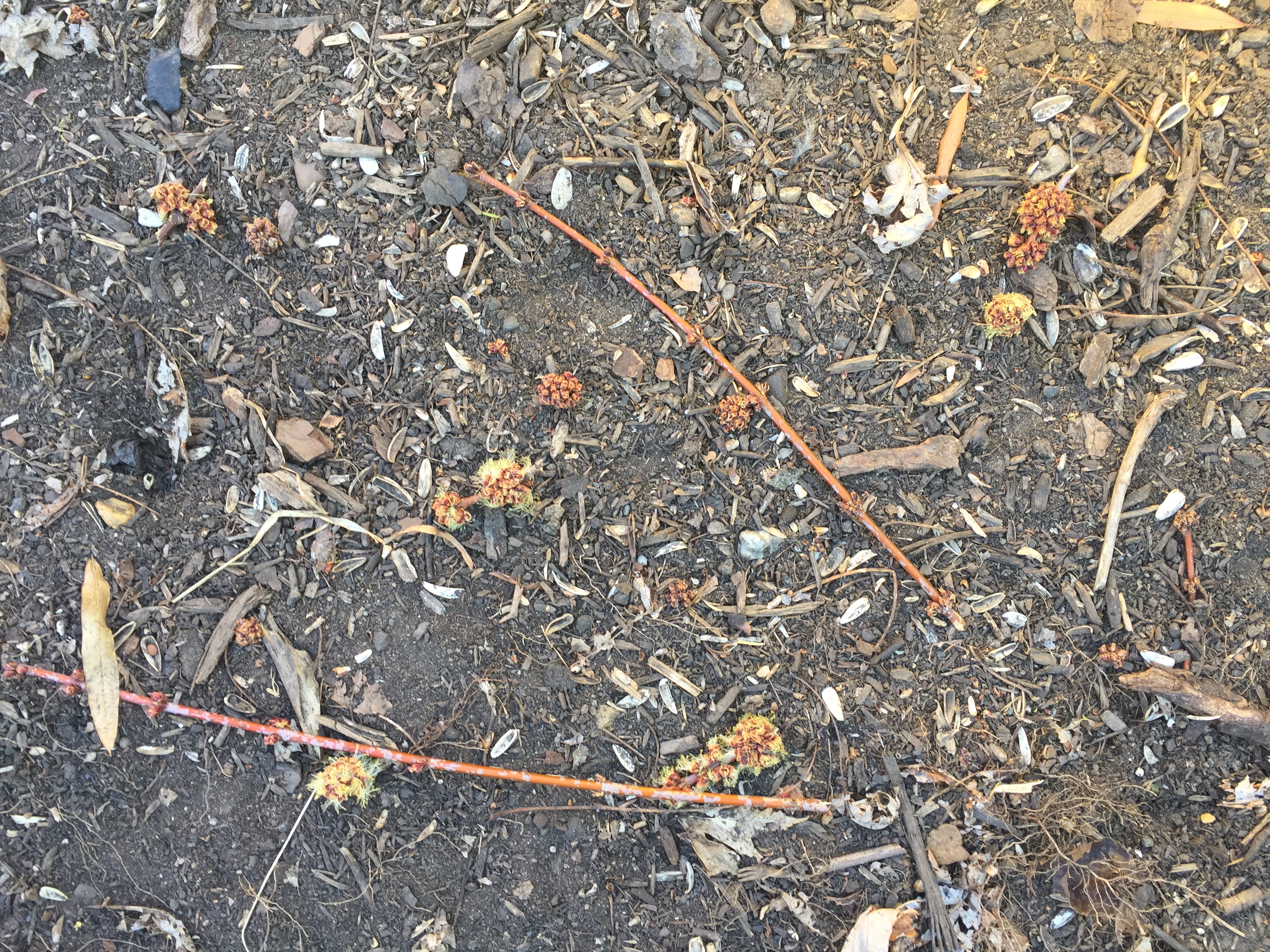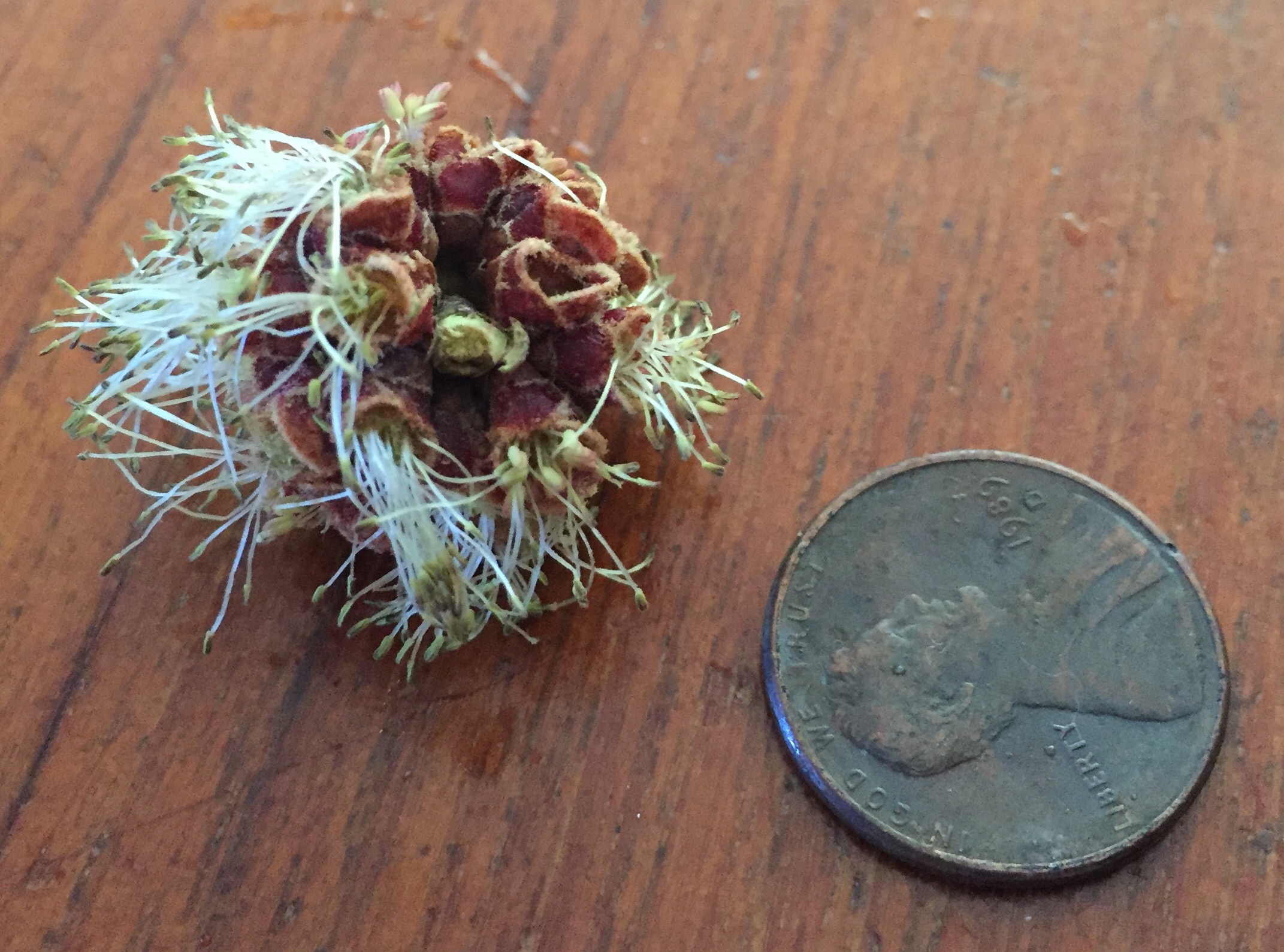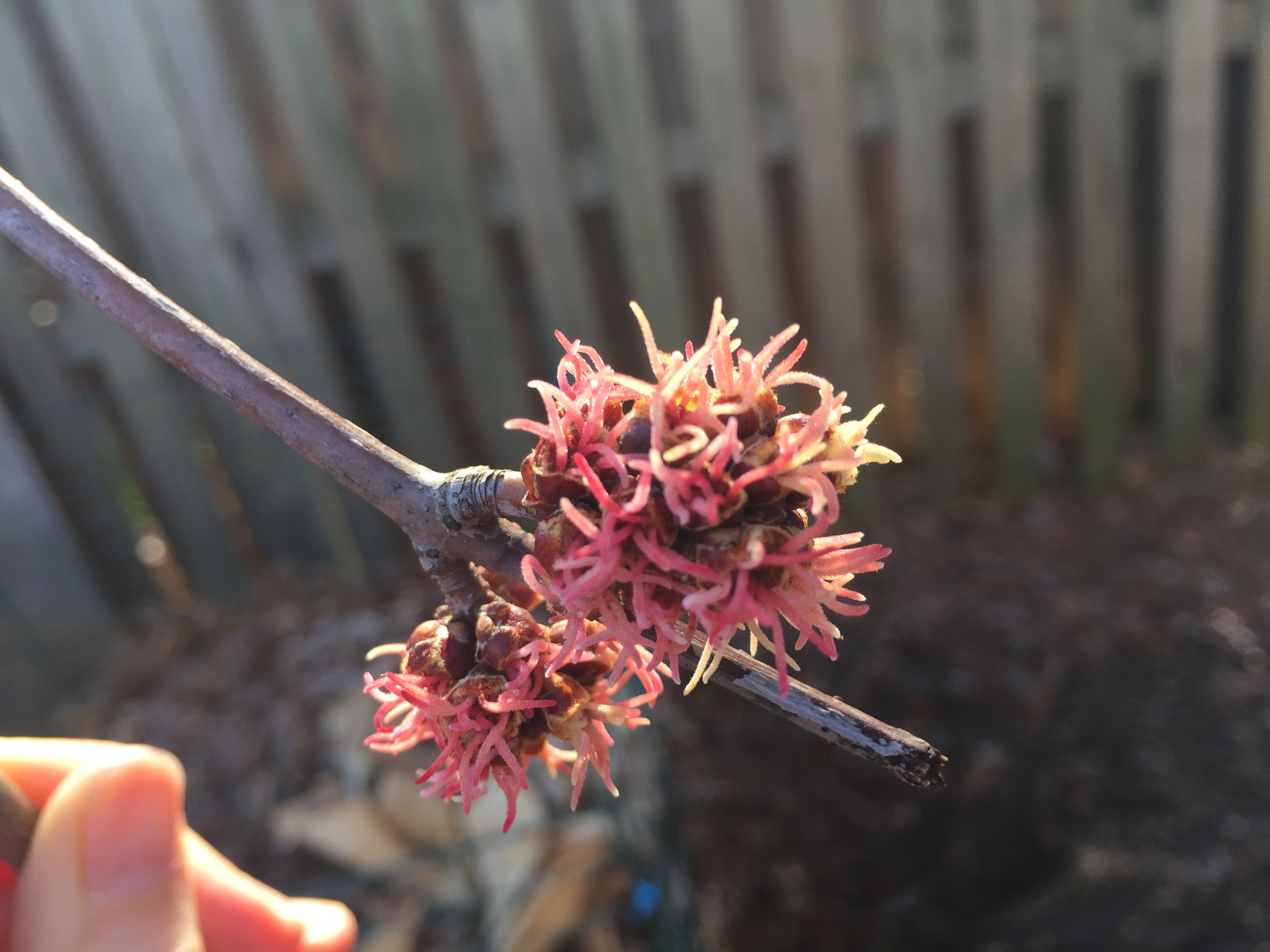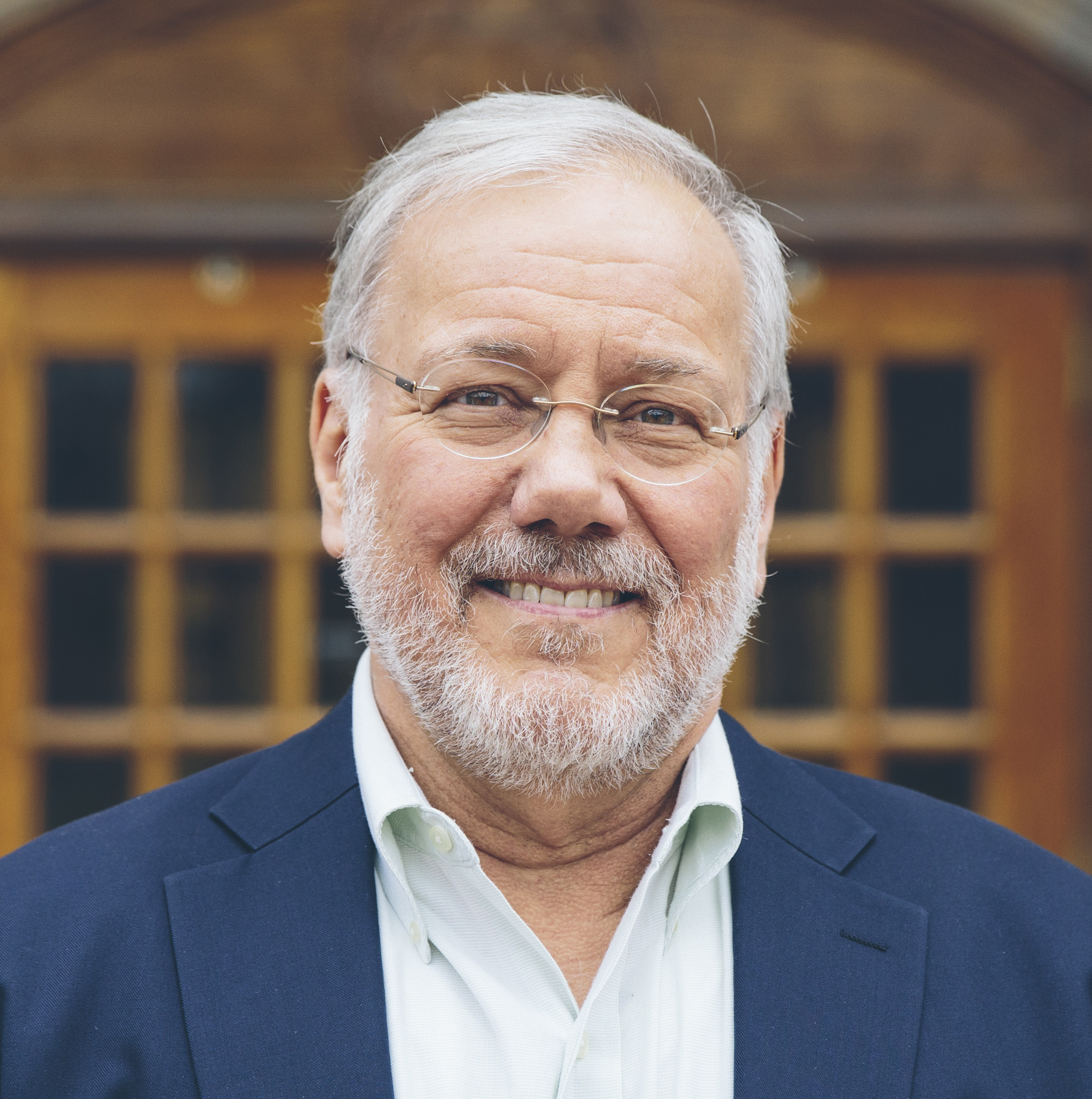Scaffolding science skills
By Mary Bigelow
Posted on 2017-02-25
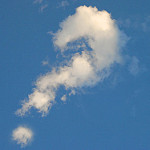 Some of my students have little experience in lab investigations. My colleague suggested I “scaffold” my instruction to help them develop lab skills, but I’m not sure what that would look like. —C., Virginia
Some of my students have little experience in lab investigations. My colleague suggested I “scaffold” my instruction to help them develop lab skills, but I’m not sure what that would look like. —C., Virginia
“Scaffolding” refers to guiding strategies designed to help students develop greater understanding of concepts and skills to become more independent learners.
Think of when you were learning to ride a bicycle. Someone first walked along with you, holding onto the seat as you pedaled. Your instructor probably gave you advice and encouragement, then let go for a few seconds until you started to wobble. Eventually you were ready to go on your own, and your instructor kept a watchful eye on you for a while.
One strategy to scaffold your students’ skill learning is with an I do->we do->you do progression:
- focused demonstrations of the skills, connecting them to what students already know
- guided practice in a variety of contexts with teacher monitoring and feedback
- opportunities for students to choose and use the skills independently (even if they make a few mistakes)
I observed an Earth science teacher scaffolding with a “think-aloud” as she demonstrated how to create graphs from a data table. This was a not a “how-to” lecture. She reminded herself of the graph’s purpose and the steps of the process, asked herself questions as she worked, and deliberately made some mistakes (correcting them in real time). It was as if the students could peek inside her mind as she worked through the process. When she paused in her thinking, the students volunteered their own suggestions. In the second part of the lesson, students worked in groups to make graphs as she monitored each group, offering suggestions and feedback.
For more suggestions:
Ed News: Teachers Eye Potential of Virtual Reality
By Kate Falk
Posted on 2017-02-24

This week in education news, teachers eye potential of virtual reality; schools zoom in on STEM equity; Louisiana considers new science standards; South Dakota’s antiscience bill is stopped; and Idaho teachers, parents, and scientists urged lawmakers to keep climate change in proposed new state science standards.
Teachers Eye Potential of Virtual Reality to Enhance Science Instruction
If you can’t afford a field trip to the International Space Station, donning a boxy black headset might be the next best thing. To take advantage of the latest in 3-D technology, teachers are increasingly expressing interest in using virtual reality to enhance science education. Click here to read the article featured on the EdSource website.
Schools Zoom in on STEM Equity
With the U.S. Department of Education doling out billions of dollars to promote diversity and to support low-income schools in 2017, administrators across the country are also working to better serve students of all backgrounds, abilities and interests. Two annual conferences this spring—the National Council of Teachers of Mathematics (NCTM) and the National Science Teachers Association (NSTA)—will feature multiple sessions designed to help educators deliver more equitable curriculums. Click here to read the article featured in District Administration.
Louisiana to Consider New Standards for Teaching Science
Next month, Louisiana’s state board of elementary and secondary education is expected to vote on new science standards. A committee worked for six months to produce new standards for the state, which currently has some of the oldest science standards in the nation. Click here to read the article featured in Education Week.
New Data: New Science Standards Are Boosting Engineering in Schools
In honor of National Engineers Week, Change the Equation “crunched some numbers, and it looks like efforts to make engineering part of the K-12 curriculum are beginning to pay off.” They believe “that the NGSS are succeeding in their aim to integrate engineering and technology into science classrooms.” Click here to read the article featured on the Change the Equation website.
South Dakota’s Antiscience Bill Stopped
South Dakota’s Senate Bill 55, which would have empowered science denial in the classroom, was defeated in the House Education Committee on February 22, 2017. A motion to pass the bill was defeated on a 6-9 vote, while a subsequent motion to defer further consideration of the bill to the forty-first legislative day — effectively killing it — passed on an 11-4 vote. Click here to read the article featured on the National Center for Science Education’s website.
Parents, Scientists to Lawmakers: Keep Climate Changes in School Science Standards
Teachers, parents and scientists urged the Senate Education Committee Thursday to keep climate change as part of the state’s new proposed science standards. Many who spoke before the committee pleaded with members to go a different direction than the House Education Committee, which voted earlier this month for the new standards but deleted references to climate change. Chairman Dean Mortimer, R-Idaho Falls, held off a committee vote until Monday, so the Senate and the House could explore options on what to do next. Click here to read the article featured in the Idaho Statesman.
Why My Students are Real World-ready with Nothing but a Device
Just as few modern-day workers could function in their jobs without a cellphone, a laptop, or periodic trips to Google, Anthony Johnson wants his students to learn how to solve problems using devices that will likely be similar to ones they will encounter for the rest of their lives. Click here to read the article featured on the eSchool News website.
Stay tuned for next week’s top education news stories.
The Communication, Legislative & Public Affairs (CLPA) team strives to keep NSTA members, teachers, science education leaders, and the general public informed about NSTA programs, products, and services and key science education issues and legislation. In the association’s role as the national voice for science education, its CLPA team actively promotes NSTA’s positions on science education issues and communicates key NSTA messages to essential audiences.
The mission of NSTA is to promote excellence and innovation in science teaching and learning for all.
Follow NSTA

This week in education news, teachers eye potential of virtual reality; schools zoom in on STEM equity; Louisiana considers new science standards; South Dakota’s antiscience bill is stopped; and Idaho teachers, parents, and scientists urged lawmakers to keep climate change in proposed new state science standards.
Career of the Month: Evolutionary Psychologist
By sstuckey
Posted on 2017-02-24
Evolutionary psychologists analyze human behavior for traits that evolved to increase the odds of survival and reproduction. They may then apply this knowledge to redesign aspects of today’s cultural institutions and practices—such as schools, workplaces, and child rearing—in ways that better align with human nature. Peter Gray is an evolutionary psychologist affiliated with Boston College. His area of focus is education, and he also writes the Freedom to Learn blog on the website of Psychology Today magazine.
Work overview.
As a retired professor, I now mostly research and write about how children educate themselves when they are free to do so. I also examine how education  data fit with evolutionary analysis.
data fit with evolutionary analysis.
A typical researcher may try to figure out which teaching method increases test scores. But when you look at education from an evolutionary perspective, you start to ask more basic questions, such as: What is the purpose of education? One experiment will not answer such questions. Instead, it’s a scholarly approach that synthesizes knowledge from different fields, such as anthropology, history, and even animal behavior.
For example, diagnoses of attention deficit hyperactivity disorder have increased possibly because society no longer tolerates children’s normal unwillingness to sit still for long periods. Instead of adapting school to children, children are being adapted to school. It’s also plausible that depriving children of play is leading to more impulsiveness, because play controls impulsiveness.
Career highlights.
My biggest fulfillment has been writing for the public, first through the blog
and then through my book, Free to Learn. Many people find meaning in my writing, and it has led to speaking invitations and other opportunities.
Career path.
I went to college planning to major in physics. But then I started thinking that the world’s biggest problems are about human behavior, and I wondered how we could bring out the better aspects of people’s being. I became more drawn to psychology and biology. After getting my degrees in psychology and biological sciences, I accepted a job in the psychology department at Boston College.
Many of the introductory textbooks seemed superficial, so I wrote one that covered the usual topics (personality, development, and so on) but from a bio-evolutionary perspective. While I was writing that book, my young son was getting in trouble for questioning his teachers.
We found an alternative school called Sudbury Valley School in Framingham, Massachusetts, where children can follow their own interests. For him, it was a dream come true, but I had my doubts. So I studied the school’s graduates and learned that they went on to do well in college and in a range of careers.
I became intrigued by children’s burning curiosity and desire to play. I began to study education from an evolutionary point of view, wondering what could be learned about children’s natural instincts by knowing about hunter-gatherer cultures.
After surveying anthropologists, I learned that in every hunter-gatherer band studied, children played and explored all day long. It was basically the same philosophy as at Sudbury, where children were free to do what they wanted, to interact with adults who were not judgmental, and to play with children in a mixed-age group. This is how they acquired the skills they needed.
Cultures evolve, sometimes in ways that run counter to human nature. Today’s schools originated at a time when it was believed that children were sinful, and one of the main goals was to break their will and drive out that sin. Humans tend to hang on to cultural things even when they are no longer functional because we are creatures of social norms. Our strong tendency to conform can help us survive in the short term but can be harmful in the long run, unless we create more suitable norms.
Knowledge, skills and training needed.
To be a scholar and researcher is to be curious, to question, and to learn new things. There shouldn’t be any transition between learning and doing.
Advice for students.
Don’t decide what field to go into based only on how you’re doing in your courses. Think about what you like to do in your free time, and that will point you to the career you should pursue.
Bonus Points
Gray’s education: BS in psychology from Columbia College; PhD in biological sciences from Rockefeller University
On the web:
www.psychologytoday.com/blog/freedom-learn;
https://evolution-institute.org; http://bit.ly/Free-to-learn
Related occupations:
biologist, anthropologist, economist
Editor’s Note
This article was originally published in the February 2017 issue of The 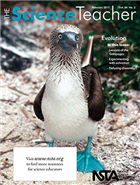 Science Teacher journal from the National Science Teachers Association (NSTA).
Science Teacher journal from the National Science Teachers Association (NSTA).
Get Involved With NSTA!
Join NSTA today and receive The Science Teacher,
the peer-reviewed journal just for high school teachers; to write for the journal, see our Author Guidelines, Call for Papers, and annotated sample manuscript; connect on the high school level science teaching list (members can sign up on the list server); or consider joining your peers at future NSTA conferences.
Maple trees and squirrels: a relationship
By Peggy Ashbrook
Posted on 2017-02-23
 The Silver maple tree is flowering, early for the season in my region, but right on schedule for the way the season is unfolding this year. Although the flowers are tiny, the details can be seen with a magnifier. When children’s attention is drawn to the small happenings in nature, it contributes to their framework for later understanding of where seeds come from and the diversity of plant life.
The Silver maple tree is flowering, early for the season in my region, but right on schedule for the way the season is unfolding this year. Although the flowers are tiny, the details can be seen with a magnifier. When children’s attention is drawn to the small happenings in nature, it contributes to their framework for later understanding of where seeds come from and the diversity of plant life.
Squirrels have bitten off, and probably eaten, the sections of the twigs just before the flowers which then drop to the ground. What are the squirrels after? Why do they do this? I see them nibbling but they aren’t eating much of the twigs.
- Squirrels have dropped Silver maple twigs and flowers.
- Silver maple tree flowers nipped off the twig by a squirrel.
- Silver maple tree flowers on the twig.
When the maple seeds are fully formed in the fall, children and scientists alike are intrigued by their motion. Squirrels go out on a limb (sorry!) to reach the seeds that develop from the flowers so they can eat the inner seed and discard the hull. Sometimes in mid-chew they drop the cluster of seeds. I ask children to examine the cluster and we discuss why some of the “wings” are empty and others hold seeds. Next Time You See a Maple Seed, a book by Emily Morgan (NSTA Kids, 2014), will help your children learn more about these seeds. The short video that goes with her book is lovely, engaging without telling, allowing children to be intrigued to explore further.
By following the growth of a single tree over the school year, children become familiar with the tree and begin to notice seasonal changes in other plants. They may not look forward to spring changes to a maple tree in the same way a squirrel does, but they begin to appreciate the interrelated lives of plants and animals.
Science 2.0: Developing the Computational Thinker
By sstuckey
Posted on 2017-02-23
For the past few issues, we have been focusing on the International Society for Technology in Education (ISTE) standards. This month, we look at the Computational Thinker standard. Its performance indicators require students to use technology-assisted methods to explore and find solutions; collect data, use digital tools to analyze them, and represent data in various ways; break problems into parts and develop models to facilitate problem-solving; and understand how automation works and use algorithmic thinking (ISTE 2016).
Working with data
Students need to become adept at collecting data, typically during labs in which they may be asked to fill in data tables. In co-author Ben Smith’s class, students would compile their data on spreadsheets, learning how to make calculations, graph and chart data, conduct analyses, and solve problems. Students can share data through a Google Form.
Further, students can learn how asking the right questions will lead to the data they desire. Initially, the questions could involve simple research such as the number of siblings, favorite color, height, or age. Data sets in Google Sheets can be used to analyze the class’s results and help students become more familiar with the data-manipulation tools. Questions on Google Forms can even require data validation, which ensures that each response meets the stated requirements.
Automating calculations in a spreadsheet or Google Sheet can find averages, sums, and data counts. Creating graphs, linear regressions, and histograms can help students make predictions and analyses that accompany each data set. Google Add-ons are tools that provide more functionality to the Sheets app.
Students should be able to use online tools (www.data.gov, www.opendatanetwork.com, and http://aws.amazon.com/datasets) to import a large data set into a spreadsheet for further analysis. This teaches about the importance of multiple trials involved in collecting large data sets. Teachers may have students work on a part of an experiment and then share their data with the class through a classwide Google Form.
On Google Trends, you can enter search terms that will yield results broken down by searches over time, by region, and by related queries. Students can use the tool to find when the next flu epidemic may be coming based on searched terms. When a second term is added to the query, students can see correlations between data sets. Searching the terms tsunami and earthquake, for instance, reveals a correlation between the two. To evidence their learning, students can first examine online infographics (e.g., www.kidsdiscover.com/infographics, www.livescience.com/infographics), and then use online tools to create infographics of their own (e.g., http://piktochart.com, https://www.easel.ly)
Students can use algorithmic thinking to learn to solve problems that lead to automated solutions. Ask students to map steps they will take in solving the problem. A concept mapping tool (such as LucidChart, MindMaps, or Popplet) allows students to create a flowchart or a decision tree to sequence the events needed to complete the solution. Additionally, Code.org has a number of activities that teachers and students can use to learn about algorithmic thinking.
Conclusion
The Computational Thinker can collect, present, and analyze data while working through a strategic solution.
Ben Smith (ben@edtechinnovators.com) is an educational technology program specialist, and Jared Mader (jared@edtechinnovators.com) is the director of educational technology, for the Lincoln Intermediate Unit in New Oxford, Pennsylvania. They conduct teacher workshops on technology in the classroom nationwide.
Reference
International Society for Technology in Education (ISTE). 2016. The 2016 ISTE standards for students. Arlington, VA: ISTE. http://bit.ly/ISTE-standards
Editor’s Note
This article was originally published in the February 2017 issue of The  Science Teacher journal from the National Science Teachers Association (NSTA).
Science Teacher journal from the National Science Teachers Association (NSTA).
Get Involved With NSTA!
Join NSTA today and receive The Science Teacher,
the peer-reviewed journal just for high school teachers; to write for the journal, see our Author Guidelines, Call for Papers, and annotated sample manuscript; connect on the high school level science teaching list (members can sign up on the list server); or consider joining your peers at future NSTA conferences.
Plate Tectonics (Student Edition)
Ocean's Effect on Weather and Climate (Student Edition)
What's So Special About Disciplinary Core Ideas? (Part 3)
By Joe Krajcik
Posted on 2017-02-22
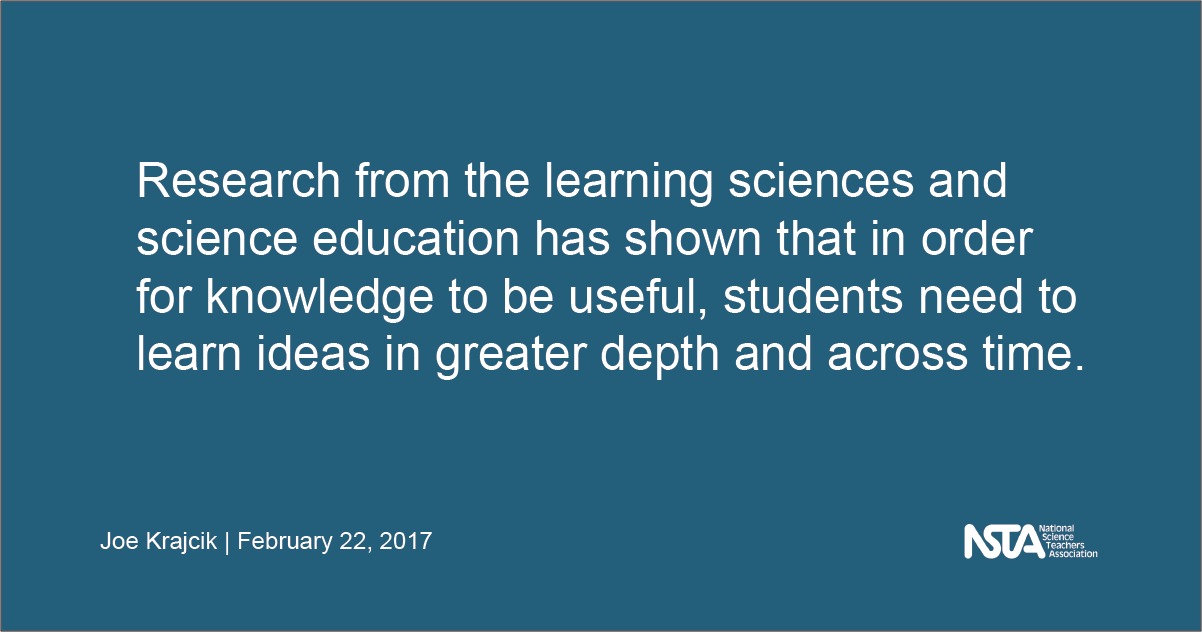
DCIs Develop Across Time
The first two blogs in my series on disciplinary core ideas (DCIs) focused on how DCIs form a conceptual framework and that DCIs provide explanations for a variety of phenomena. In this final blog I’d like to focus on an important idea reflected in A Framework for K–12 Science Education (Framework) that DCIs are not stand-alone, individual facts that students come to “know” as the result of one lesson or across one grade. Rather, DCIs develop in ways that become progressively more sophisticated as students use those ideas to make sense of new phenomena or problems within and across the grade levels. What is meant by more sophisticated? It means that students’ explanations become deeper and broader allowing them to explain more fully the causes and consequences of a wider array of related phenomena. Sophistication also means that DCIs become integrated with more ideas and experiences. Sophistication is not acquiring more ideas and more details; rather, it is about making connections to ideas and experiences. As ideas get more sophisticated, students come to understand the cause and effect mechanisms that underlie a range of phenomena.
Research from the learning sciences and science education has shown that in order for knowledge to be useful, students need to learn ideas in greater depth and across time. The DCIs are introduced to students in early grades and develop throughout the K–12 years and beyond. As such, core ideas form a strong foundation to promote continual learning throughout one’s life. Building ideas across time supports learners in developing deeper and more meaningful and sophisticated understandings by forming connections among ideas. These connections will allow learners to apply the understandings to new and novel situations.
For most science educators, taking a developmental approach to teaching science is new. As teachers and curriculum designers, we need to carefully link new learning and experiences to what students have previously learned, allowing the ideas to become more sophisticated over time. The idea of building on previous ideas is one of the most solid ideas in learning; unfortunately, in the past we’ve seldom given it the attention it deserves. For example, some textbooks present ideas about the water cycle that are dependent on understanding that matter is made of particles, without providing the help students need to develop this idea. The Framework emphasizes the importance of taking a developmental perspective focused on developing ideas over time and building on students’ prior knowledge and experiences.
A developmental perspective requires us, as teachers and curriculum designers, to build and link to students’ current understanding to form richer and more connected ideas over time (NRC 2007). Disciplinary core ideas should develop from elementary through high school. Each year the ideas become more sophisticated, allowing students to provide more complete explanations of phenomena as well as explain more phenomena.
A developmental perspective guides students’ knowledge toward a more sophisticated and integrated understanding of the scientific idea. For example, if by the end of 5th grade we can help students know and apply the idea that forces acting on an object can cause changes in the object’s speed or direction, we can help learners in later grades develop deeper ideas of forces, including those at the intermolecular level. Similarly, helping 3rd-grade students understand that changes in the environment will cause some organisms to survive and reproduce, others to move to a new location, and others to die off, can lead to deeper understanding of natural selection and evolution in middle school and high school. The grade band endpoints in the Framework show this progression of ideas across time. In Disciplinary Core Ideas: Reshaping Teaching and Learning (Duncan, Krajcik, & Ravit 2016) various chapters on the DCIs discuss how they develop across time. Examples of how teachers can support student learning at various steps is also presented and discussed.
The developmental perspective also stresses that teaching more content, devoid from the use and application of those ideas, does not allow students to explain or reason about phenomena. Students can memorize science principles, but not really understand them. It helps to reflect back on our own experiences. I remember being able to solve the problems in my college physics class, but I didn’t understand the ideas behind what I was doing or how to apply those ideas to the world in which I lived.
It is critical to realize that growth in understanding is not developmentally inevitable, but depends on what we do in our teaching to provide key learning experiences that help students develop the ideas to become more sophisticated. Reaching the various endpoints depends on the instruction the student receives and how understanding is assessed. Disciplinary Core Ideas: Reshaping Teaching and Learning (Duncan, Krajcik & Ravit 2016) presents some ideas to move students from one level to another, but development of coherent curriculum materials that build understanding across time is needed.
Concluding Thoughts
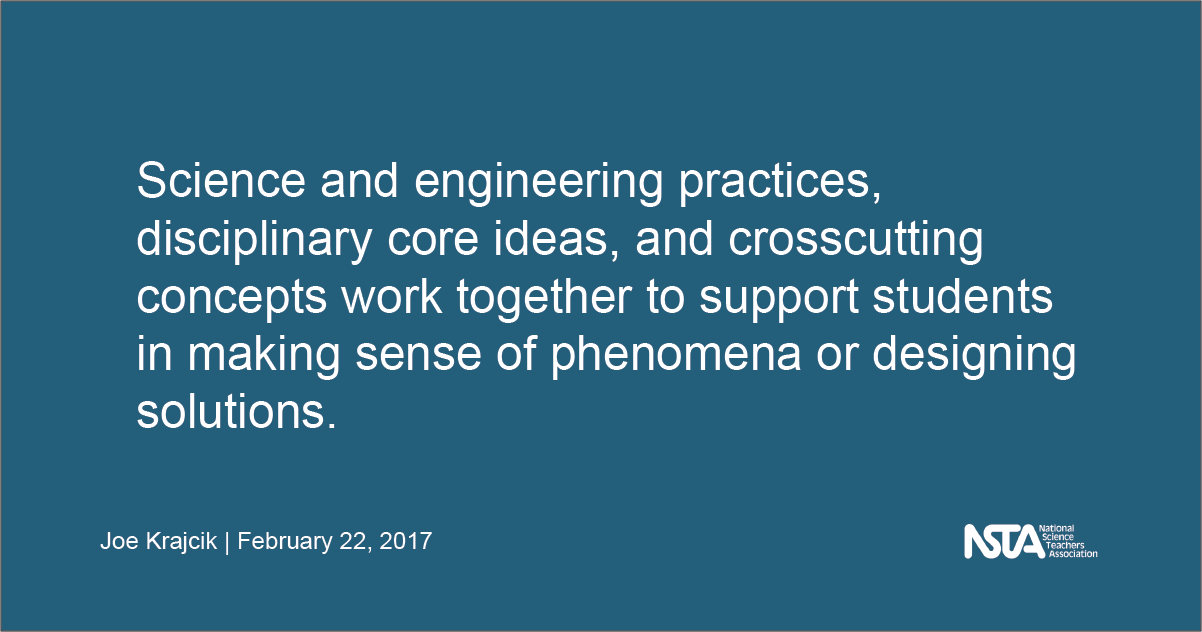 Deep, meaningful understanding of disciplinary core ideas are essential to predict and explain phenomena, but DCIs serve as only one dimension in developing this useable knowledge. Science and engineering practices, disciplinary core ideas, and crosscutting concepts work together to support students in making sense of phenomena or designing solutions. Rather than “learning” numerous disconnected ideas, the Framework focuses on helping learners develop a useable understanding of fewer, powerful ideas that develop across K–12-science curriculum and can form conceptual tools that learners can use to make sense of the world. Classroom instruction and curriculum materials will need to support students in reaching these important ideas. As such, curriculum materials and instruction focus on making sense of phenomena using the DCIs, scientific and engineering practices, and core ideas.
Deep, meaningful understanding of disciplinary core ideas are essential to predict and explain phenomena, but DCIs serve as only one dimension in developing this useable knowledge. Science and engineering practices, disciplinary core ideas, and crosscutting concepts work together to support students in making sense of phenomena or designing solutions. Rather than “learning” numerous disconnected ideas, the Framework focuses on helping learners develop a useable understanding of fewer, powerful ideas that develop across K–12-science curriculum and can form conceptual tools that learners can use to make sense of the world. Classroom instruction and curriculum materials will need to support students in reaching these important ideas. As such, curriculum materials and instruction focus on making sense of phenomena using the DCIs, scientific and engineering practices, and core ideas.
It is also important to realize that DCIs are for all students in our nation. All learners need to develop a sophisticated understanding of DCIs so that they can be used along with science and engineering practices and crosscutting concepts to make sense of the world. Developing useable knowledge will help ensure that we have a sustainable and free world in which to live. If given the chance I might tweak some of the physical science core ideas; but, I am convinced that the full spectrum of DCIs, along with the science and engineering practices, are good guides for our teaching and learning.
 I would love to hear from you about the ideas in this blog, your ideas, questions, and feedback. Tweet me at @krajcikjoe or email me krajcik@msu.edu. If you want to learn more about the disciplinary core ideas take a look at our new book, Disciplinary Core Ideas: Reshaping Teaching and Learning, edited by Ravit Duncan, Joe Krajcik, and Ann Rivet, just published by NSTA Press.
I would love to hear from you about the ideas in this blog, your ideas, questions, and feedback. Tweet me at @krajcikjoe or email me krajcik@msu.edu. If you want to learn more about the disciplinary core ideas take a look at our new book, Disciplinary Core Ideas: Reshaping Teaching and Learning, edited by Ravit Duncan, Joe Krajcik, and Ann Rivet, just published by NSTA Press.
References
American Association for the Advancement of Science (1993). Benchmarks for science literacy. New York: Oxford University Press.
Duncan, R., J. Krajcik, and A. Ravit eds. 2016. Disciplinary Core Ideas: Reshaping Teaching and Learning. Arlington, VA: National Science Teachers Association Press.
Fortus, D. and J. Krajcik. 2011. Curriculum Coherence and Learning Progressions in The International Handbook of Research in Science Education (second edition) Fraser, B. J., K. G. Tobin, and C. J. McRobbie, eds. Dordrecht: Springer.
National Research Council (NRC). 2012. A framework for K–12 science education: Practices, crosscutting concepts, and core ideas. Washington DC: National Academies Press.
Stevens, S., L. Sutherland, and J. S. Krajcik. 2009. The Big Ideas of Nanoscale Science and Engineering. Arlington, VA: National Science Teachers Association Press.
_____________________________________________________
Editor’s note: This blog is the last in a series of three by Joe Krajcik that explore the NGSS disciplinary core ideas.
Joe Krajcik (Krajcik@msu.edu) is a professor of science education at Michigan State University and director of the Institute for Collaborative Research for Education, Assessment, and Teaching Environments for Science, Technology and Engineering and Mathematics (CREATE for STEM). He served as Design Team Lead for both the Framework and the NGSS.
The mission of NSTA is to promote excellence and innovation in science teaching and learning for all.
Future NSTA Conferences
2017 National Conference
STEM Forum & Expo
Follow NSTA

DCIs Develop Across Time
Ideas and inspiration from NSTA’s February 2017 K-12 journals
By Mary Bigelow
Posted on 2017-02-19
All three journals this month include the inaugural Best STEM Books for Students K–12 with descriptions and reviews. The rubric and criteria used in selecting these books is also provided. Share it with your librarian, too.
Crowdfunding for Elementary Science Educators in S&C has fund-raising ideas applicable to any grade level.
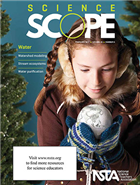 Science Scope — Water
Science Scope — Water
From the chemistry of water to the biology of water habitats and ecosystem to the relationship of water and weather to the importance of water in the body to current events related to access to clean water, water is indeed an Essential Substance.
Featured articles that describe lessons include a helpful sidebar (“At a Glance”) documenting the big idea, essential pre-knowledge, time, and cost. The lessons also include connections with the NGSS.
- Supporting Student Understanding of Watersheds by Using Multiple Models to Explore Elevation shows how a variety of models and maps can help students understand the flow of water in a watershed and its relation to elevation.
- If you are looking for a context in which to help students understand the concept of systems, take a look at Learning and Applying Systems Thinking When Studying a Local Creek System. The article includes student diagrams.
- From Fish Tank to Fuel Tank: Engineering Photobioreactors in the Classroom describes a multidisciplinary activity in which students grew algae as a potential source of renewable energy.
- Water, Water, Everywhere! But Is It Clean to Drink? Applying Engineering Design to the Challenge of Water Purification takes a problem-solving approach to this topic.
- The 5E lesson in An Inquiry Lesson on Stream Ecosystems shows students how the distribution of aquatic macroinvertebrates relates to the characteristics of a stream. There are suggestions for modifying this investigation if you aren’t near a stream, too.
- Science on a Shoestring: Testing the Waters includes directions for making and using a mini Secchi disk to measure water turbidity.
- With the Citizen Science: Citizen Science for a Rainy (or Snowy) Day project, your students can contribute to a national database of precipitation data, which can be used by the National Weather Service, NASA, USDA, researchers, and emergency management.
- Disequilibrium: Sticking Together has a 5E lesson on the cohesive properties of water.
- Teacher to Teacher: Designing the Water Treatment Process has a timely lesson on creating and testing models of treating water.
- Find ideas and suggestions from other teachers in this month’s Listserv Roundup: Teaching the Water Cycle.
For more on the content that provides a context for these projects and strategies see the SciLinks topics Algae, Aquatic Ecosystems, Eclipses, Freshwater Ecosystems, Groundwater, Ocean Water Chemistry, Photosynthesis, Water Cycle, Water Properties, Water Quality, Water Treatment, Watersheds
Continue for The Science Teacher and Science and Children
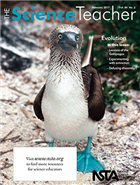 The Science Teacher — Evolution
The Science Teacher — Evolution
The featured articles in this issue focus on evolution as a foundation and unifying theme of biology, helping us to understand the diversity of living things and how they are interconnected. In the Editor’s Corner: This View of Life, the editor shares advice for when a student has religious concerns for learning about evolution.
The lessons described in the articles include connections with the NGSS.
- In some communities, Evolution is a controversial topic. The commentary It’s About Time to Teach Evolution Forthrightly has suggestions for improving our teaching of evolution and supporting our colleagues to do so.
- Staying Within the Law addresses some of the legal implications of teaching evolution in public schools. A must-read!
- Defusing Discomfort describes a writing process that could be adapted to any controversial topic and provides an outlet for student views. The article includes examples of prompts related to evolution.
- Get ready for a virtual field trip. The 5E lesson in Lessons of the Galápagos explores the unique biology of these islands and how they were a “laboratory” for studying evolution.
- Experimenting With Extinction shows how students can design and test hypotheses about the extinction of cat species using historical data
- Career of the Month: Evolutionary Psychologist features an interview and description of this interdisciplinary field.
- Focus on Physics: Newton’s (Often Misunderstood) Third Law of Motion is an easy-to-read discussion that could be shared with students.
- The authors of Idea Bank: Skip the Cell Unit advocate for teaching about cells in context, rather than as an isolated unit focusing on the parts of a cell.
For more on the content that provides a context for these projects and strategies see the SciLinks topics Charles Darwin, Darwin and Natural Selection, Evolution, Evolution of Man, Evolutionary Biology, Extinction, Galapagos Islands, Natural Selection, Vertebrate Evolution, Newton’s Third Law
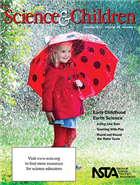 Science & Children – Early Childhood Earth Science
Science & Children – Early Childhood Earth Science
Young children are full of curiosity and are eager to experiment (“play”) with objects and phenomena. Early intervention is a key to tapping into this curiosity. This issue has many ideas that are appropriate for young (and maybe not-so-young) students.
The lessons described in the articles include connections with the NGSS.
- In addition to a 5E lesson for student investigations, Acting Like Rain has charts that show how Pre-K activities can align with elementary NGSS and Common Core.
- Play is what children do best! Teaching With Play taps into their excitement with a lesson on environmental science (helping or hurting the environment) and pollution. The article includes photos of the children’s work.
- As an alternative to storybooks the author of Interactive Reading suggests how to incorporate informational texts into read-alouds for young children.
- It’s not too early to begin the Countdown to the Great American Eclipse, the first total solar eclipse in the continental US since 1979, especially since your school might not be in session on August 21.
- The Early Years: Looking at Landscapes has a lesson for using the playground as a lab for studying landforms and erosion.
- Teaching Through Trade Books: Focusing on Earth’s Features provides two 5E lessons for helping students model and understand landforms and patterns.
- Poetry of Science: Water, Water, Everywhere has ideas for combining science and language. Perhaps your students could create similar poems?
- The Science 101 column provides resources for the questions children ask. This month features Why Do We Only See One Side of the Moon?
- Integrating the Arts with the design process is the focus Engineering Encounters: From STEM to STEAM, as students design and test rollercoasters.
- Using age-appropriate activities and informational books, the author of Round and Round the Water Cycle describes how to craft learning activities that can be the foundation for future learning. Examples of student work are provided.
For more on the content that provides a context for these projects and strategies see the SciLinks topics Eclipses, Habitats, Landforms, Moon Phases, Plate Tectonics, Roller Coasters, Solutions to Pollution Problems, Volcanoes, Water Cycle, Watersheds
All three journals this month include the inaugural Best STEM Books for Students K–12 with descriptions and reviews. The rubric and criteria used in selecting these books is also provided. Share it with your librarian, too.
Crowdfunding for Elementary Science Educators in S&C has fund-raising ideas applicable to any grade level.



